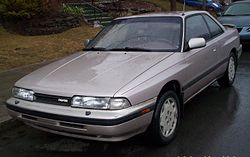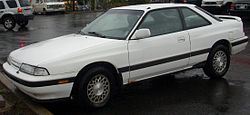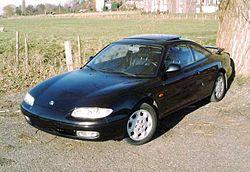- Mazda MX-6
-
Mazda MX-6 
Manufacturer AutoAlliance International
MazdaProduction 1988–1997 Assembly Flat Rock, Michigan, United States
Hiroshima, Japan
Hofu, JapanPredecessor Mazda 626 coupé Class Sport compact Body style 2-door coupé Layout FF layout Transmission 4-speed automatic
5-speed manualThe Mazda MX-6 was a front-wheel drive sporty coupé produced by Mazda between 1987 and 1997. It was called the Mazda Capella in Japan until 2002 before being renamed Mazda Atenza/Mazda6.
The MX-6 was mechanically identical to the Mazda 626 and subsequently the Ford Probe. These cars shared the GD (1988–1992) and GE (1993–1997) platforms. The MX-6 replaced the 626 Coupé, although it continued to share the same chassis. Mazda shared the GD and GE chassis with Ford for their own Probe. The MX-6, 626 and Ford Probe were made together in joint-venture plants either by AutoAlliance in Flat Rock, MI for the North American market, and by Mazda Japan for Asian and European Markets.
Contents
First generation (1988–1992)
First generation 
Also called Mazda 626 Coupé
Mazda Capella C2Production 1988-1992 Platform Mazda GD platform Engine North American market
2.2L 145 hp (108 kW) I4 F2
2.2L 110 hp (82 kW) I4 F2
2.2L 145 hp (108 kW) I4 F2T
European market
1.8L 80 hp (60 kW) I4 F8
2.0L 112 hp (84 kW) I4 FE
2.0L 145 hp (108 kW) I4 FE-DOHC
Japanese Domestic market
1.8L 80 hp (60 kW) I4 F8
2.0L 145 hp (108 kW) I4 FE-DOHCWheelbase 99 in (2,514.6 mm) Length 177 in (4,495.8 mm) Width 66.5 in (1,689 mm) Height 53.5 in (1,359 mm) Related Ford Probe
Mazda 626
Mazda CapellaThe first generation MX-6 appeared in 1988 and lasted until 1992 in the United States. In some markets the model years were from 1987 to 1991. It was based on a series of futuristic sports compact concept cars of the early 1980s. It was a large coupé, based on the Mazda GD platform, and was powered by the I4 Mazda F engines.
The US market made use of the F2 2.2 L engine, with the base engine produced 120 hp (82 kW), but a 145 hp (108 kW) turbocharged version was available. European and Japanese market versions were shipped with either the F8 1.8 L, FE 2.0 L or FE-DOHC 2.0 L DOHC engines.
The MX-6 was produced with two transmission options, a five-speed manual transmission or a four-speed automatic with overdrive. The MX-6 was also known to be a very reliable car, mechanically.
This generation was available in several trim levels, which differ depending on the market the vehicle was sold in. In the United States, the MX-6 was available in DX, LX, LE, and GT trim levels:
- DX was the "bare bones" model, offering the base 120 hp (89 kW)/130 lb·ft (176 N·m) F2 2.2 L engine and few options, but most MX-6s sold in the U.S. were equipped with air conditioning.
- LX added power windows, power locks, and power mirrors, as well as an optional electric moonroof.
- LE was a rare "Leather Edition" model that was the same as the LX, but included leather seating surfaces and a leather wrapped shift knob on manual transmission-equipped vehicles.
- GT included all options from the LX, but also stepped up to the F2T 2.2 L turbocharged, intercooled engine, which put out 145 hp (108 kW) and 190 lb·ft (258 N·m) of torque delivering a significant performance boost. It also had four-wheel disc brakes with ABS as optional, and three-way electronically adjustable suspension, dubbed AAS.
In 1989, Mazda offered a special four-wheel steering (commonly abbreviated 4WS) option on MX-6 GTs destined for the U.S. This system consisted of an electronically controlled rear steering rack that turned the rear wheels opposite to the fronts at low speeds to improve cornering, and turned the rear wheels with the fronts at high speeds to improve highway lane change maneuvering. This option was available through all years for GT models in other markets.
European spec vehicles shipped as the 626 Coupé and commonly received either the 1.8 L SOHC F8 or 2.0 L SOHC FE engine in GLX models, or the 2.0 L FE-DOHC engine in their GT models. 4WS was a common option for European 626 Coupés. Australian vehicles were almost always equipped with the 2.2 L turbocharged F2T engine as the US models, as well as 4WS. They also carried the MX6 name of the American models.
Asian spec vehicles were shipped as the Capella C2 and were available in several trims, most notably GT-R (FE-DOHC and 4WS), GT-X (FE-DOHC and AAS) or GT-S (F8 and 4WS or AAS).
New Zealand received vehicles in either European spec or Australian spec, selectable on order. As such, NZ GTs can have either the F2T 2.2 L turbocharged engine or the FE-DOHC 2.0 L DOHC, with optional 4WS.
Second generation (1992-1997)
Second generation 
Also called Mazda MX-6 Mystère (For Canada) Production 1992-1997 Platform Mazda GE platform Engine 2.0L 119 hp (89 kW) I4
2.5L 164 hp (122 kW) V6 (KLDE)
2.5L 198 hp (148 kW) V6 (KLZE)Wheelbase 102.8 in (2611 mm) Length 177.5 in (4610 mm) Width 68.9 in (1750 mm) Height 51.6 in (1311 mm) Curb weight GVWR 2775 lb (1259 kg) 93 MX-6 LS 2.5 Related Ford Probe
Mazda 626
Eunos 500 (Mazda Xedos 6)
Mazda CapellaIn 1993 Mazda unveiled the new MX6, commonly referred to as the second generation. It used the new GE platform, shared by the 626 and Ford rebadged cars, the Ford Probe and the Ford Telstar. It was released in three distinct variants worldwide, known as A-spec, E-spec and J-spec, which relates to their destined markets – US, Europe and Japan, respectively.
A-spec
The A-spec variant was for the North American market only. It was built alongside the Ford Probe and Mazda 626 from 1992 as a 1993 model by AutoAlliance International in Flat Rock, Michigan. There were three trim levels available on the A-spec models:
- 'RS' - Base model, fitted with the FS-DE 2.0 DOHC I4 engine, making 118 hp (88 kW).
- 'LS' - Luxury model, fitted with the KL-DE 2.5 DOHC V6 engine, making 164 hp (122 kW). It was also equipped with alloy wheels, a low rear spoiler, an optional cd player, foglights and leather or cloth interior.
- 'LS M-edition' - A special edition based on the LS, including different, all-red tail lights, chrome scuff plates, an indash 3-disk CD stacker, gold alloy wheels (same design as LS), all gold badges, and M-edition embroidered on the front seats and floor mats. M-editions only came in three paint colors: a trim exclusive burgundy , black, and white. All with cream leather interior and special gold pin striping. The A-Spec models never received 4WS.
In 1995 the second generation MX6 was refreshed with different 5-spoke alloy wheels, twin airbags and emissions changes.Another major change after 1995 was the addition of OBD-II to the car. With this addition the 164 hp (122 kW) was decreased to 160 hp (120 kW) for every year thereafter. Known as the 'GE2', this model ran until 1997. Interesting to note is that unlike the first generation, the second generation MX6 only had one model with a different moniker - the Canadian MX-6 Mystère.
E-spec
Built from 1991 in Japan, for Australia, New Zealand, and Europe. Compared to the G-spot, it has different headlights (a two-piece projector setup giving far greater lighting) and taillights, different front and rear bumpers, fog lights, wing-mirrors (power+heated), steering wheel, interior trim and alloys as standard. The side indicator lights were mounted behind the front wheels, and there are no corner bumper lights. It also came with optional air conditioning and leather interior (standard from 96), and the MX6’s main act – the 4WS system (not available in the UK). The engine was the same as the US version (although not limited by lower octane fuels) – the KL-DE 2.5 DOHC V6 engine, again making 164 hp (122 kW) and with the higher octane fuels used in Europe as standard, slightly lower mpg but with greater performance.
In Australia, the MX-6 was released in November 1991. Only one trim was available. Equipped with the KL-DE 2.5 DOHC V6 engine, sunroof, 4WS etc., with the only remaining options being leather and electric seats. September 1994 was the release of the GE2 update model. Like Mazda Australia did with the GD2, there were now two choices – the 4WS all options MX6, or the 2WS version. They both had new wheels, interior trim, and steering wheel, but only the 4WS version got the sunroof, CD player, leather (which actually only became standard in late '96) and the digital climate control. The MX-6 lasted until 1997, with the last few rolling out of dealers in 1998.
J-spec
This version was also released in 1991, and is very similar to the E-spec (as they are built in the same place), but with minor changes. One piece headlights were fitted, with indicators incorporated in the fog light housing, as well as a different rear bumper with smaller registration plate cutout, similar to the A-spec. Almost everything was an option, but the 4WS was available, as well as the digital climate control, electric folding mirrors, larger centre console, and of course, the Mazdaspeed body add-ons – a subtle lip kit with Supra-style high rise rear spoiler.
Engine choice was the KL-ZE 2.5 DOHC V6 making 200 bhp (150 kW), a high compression version of the KL-DE, or the KF-ZE 2.0 DOHC V6 making 159 bhp (119 kW), all of the K series engines in the MX6 were based on the same engine block and included those found in the Ford Probe, Xedos 6 and MX-3 V6 models. The KLZE had appromixately 40 more horsepower than the KLDE versions for a few reasons. Although the displacement was the same, the KLZE had more durations on the cams, higher compression due to a different shape of pistons, and the intake manifold was different on the ZE. The KL-ZE intake manifold runners were shorter and wider than the KL-DE manifold. Also, the heads on the KL-ZE were ported and shaped differently. Not only was the ZE higher in compression, but was also a higher reving engine as well. The only flaw in the KL-ZE design were the weaker valve springs on the intake valves. This is usually corrected by using the KL-DE springs, keepers, and retainers which are a little stronger. A J-Spec KL-ZE with low mileage on it can easily be had for $800.00 to $1200,00 from most Japanese engine importers.
The J-spec MX6s are now quite common around the world, from the UK to Australia and NZ, with the KL-ZE engine conversion alone being popular worldwide. These motors can be purchased for $600–1000 Canadian from most JDM importers.
4WS (Four Wheel Steering)
Used from 1987-1997 on the majority of MX-6s around the world[citation needed], this was the MX-6s centerpiece.
It was available on both generations, although the North American market only received it for the 1989 model year. South African MX-6s never received 4WS.
According to Mazda, the system provided:- Superior cornering stability
- Improved steering responsiveness and precision
- High-speed straightline stability
- Notable improvement in rapid lane-changing maneuvers
- Smaller turning radius and tight-space maneuverability at low vehicle speed range
The system electronically controlled a rear rack that was behind the rear wheels. At low speeds (of up to 35 km/h), the rear wheels would move in the opposite direction to the front wheels, aiding parking and U-turns by lowering the turning circle. Above these speeds, the rear wheels would move in the same direction as the fronts, meaning control during high speed manoeuvres such as lane changes or cornering was improved. Either way, the turning angle of the rear wheels was slight at just five degrees, a measurement Mazda determined to be optimally effective and natural to human sensitivity.
Note:- When the engine is turned off, the rear wheels would straighten up. They would change back to the angle of the front wheels when the engine is restarted. This is caused by the 4WS control unit powering down, and the failsafe system overriding the rear rack.
- If the system ever faults, as a failsafe the rear wheels would lock straight to allow the vehicle normal 2WS functionality.
Models
Year Model Engine Power Torque 0–60 mph (97 km/h) 1/4 mi (0.4 km) Top speed 1988–1992 DX, LX, LE 2.2 L (2184 cc) F2 I4 110 hp (82 kW) 130 ft·lbf (176 N·m) sub 9 secs 16.5 at 88 mph 126 mph (202 km/h) 1988–1992 GT 2.2 L (2184 cc) F2T turbo I4 145 hp (108 kW) 190 ft·lbf (258 N·m) 7.5 15.7 at 92 mph 130 mph (209 km/h) 1993–1997 RS 2.0 L (1991 cc) FS I4 118 hp (88 kW) 127 ft·lbf (172 N·m)) 116 mph 1993–1997 LS 2.5 L (2497 cc) KL-DE V6 164 hp (122 kW) at 5600 rpm 160 ft·lbf (212 N·m) at 4500 rpm 7.6 15.8 at 92 mph (148 km/h) 138 mph (224 km/h) 1993–1997 LS 2.5 L (2497 cc) KL-ZE(J-Spec) V6 200 hp at 6500 rpm 165 ft·lbf (212 N·m) at 5500 rpm 6.2 14.9 at 97 141 mph (~225–230 km/h) References
- Patrick Bedard. "Mazda MX-6 LS". Car and Driver (August 1992): 55–59.
- Mazda Australia 4WS explanation and history
External links
- MX6OC.COM - UK Mazda MX6 Owners Club
- MX6.com - USA MX6 forums
- UKPOC United Kingdom Probe Owners Club excellent technical advice and information
- Ford Probe Store, Specialist online store for Ford Probe & Mazda MX3/6, UK Based, ships to Europe
« previous — Mazda road car timeline, 1990s–present Type 1990s 2000s 2010s 0 1 2 3 4 5 6 7 8 9 0 1 2 3 4 5 6 7 8 9 0 1 Kei car Carol Carol Carol Carol Carol AZ-Wagon AZ-Wagon AZ-Wagon AZ-Wagon AZ-Offroad Spiano Scrum Scrum/Scrum Wagon Scrum/Scrum Wagon Subcompact Revue/121 Demio/121 Demio/Mazda2 Demio/Mazda2 Verisa Compact Familia/323/Protegé Familia/323/Protegé Familia/323/Protegé Axela/Mazda3 Axela/Mazda3 Familia Van Familia Van Familia Van Mid-size Capella/626 Capella Capella/626 Atenza/Mazda6 Atenza/Mazda6 Cronos/626/Xedos 6/Eunos 500 Eunos 800/Xedos 9/Millenia Mazda6 (N.America) Full-size Sentia/929/Efini MS-8 Sentia Sports car AZ-1 MX-3 Precidia Roadster/MX-5/Miata Roadster/MX-5/Miata Roadster/MX-5 MX-6/Mystère MX-6/Mystère/Efini MS-6 RX-7 Efini RX-7/RX-7 RX-8 Cosmo Minivan Premacy Premacy/Mazda5 Premacy/
Mazda5Bongo Friendee Biante Efini MPV/MPV MPV MPV/Mazda8 Crossover CX-7 CX-9 SUV Navajo Tribute Tribute Pickup B-Series B-Series B-Series BT-50 BT-50 Van Bongo Bongo Categories:- Mazda vehicles
- Front wheel drive vehicles
- Front wheel drive sports cars
- Vehicles with four wheel steering
- Sport compact cars
- Coupes
- Vehicles introduced in 1988
- 1980s automobiles
- 1990s automobiles
Wikimedia Foundation. 2010.
